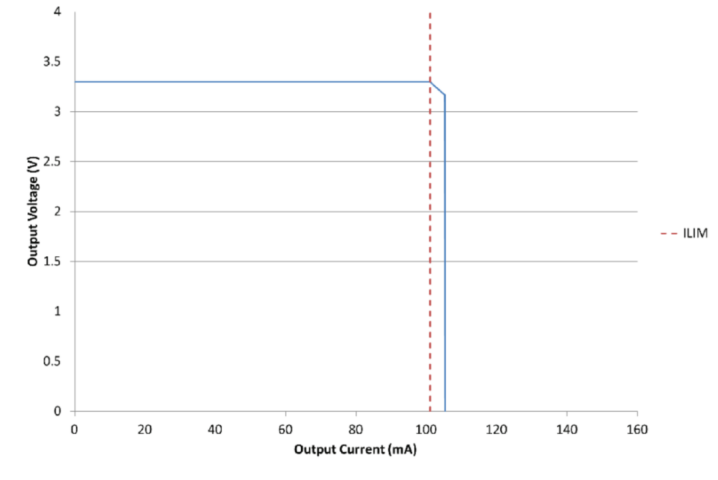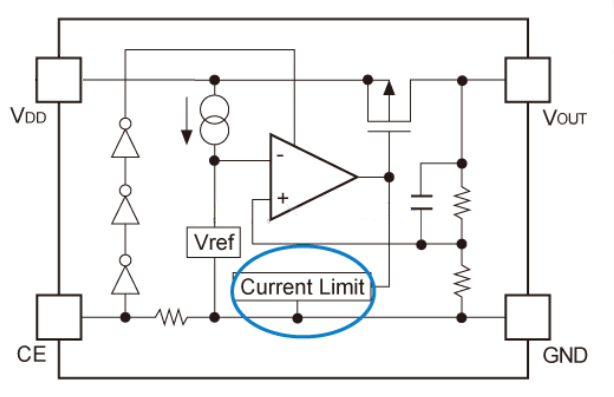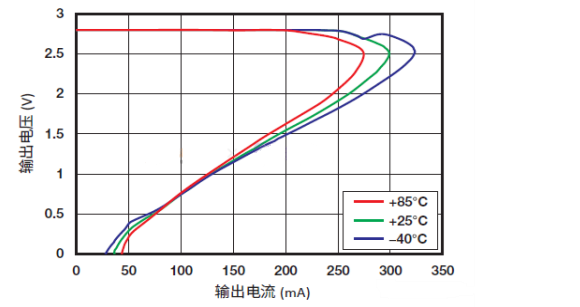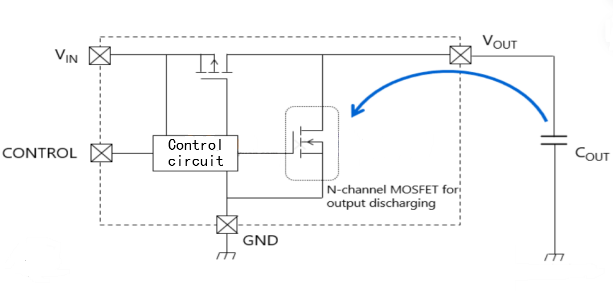LDOs regulate their output voltage to ensure stable operation under varying load current demands. However, when the load current exceeds the designed range, such as in a short circuit or overload, the excessive current can cause chip overheating or even damage. To address this, overcurrent protection mechanisms have emerged to limit the output current and protect both the LDO and its load. LDOs typically have two overcurrent protection mechanisms: brick-wall current limiting and overcurrent shutdown.
1. Brick-Wall Current Limiting
As the name suggests, brick-wall current limiting is a "hard" cutoff mechanism. When the output current exceeds the preset current limit, I_LIMIT,
the LDO quickly limits the output current to I_LIMIT. Due to the high load current, the LDO temperature gradually rises. Once the LDO protection temperature is triggered, the LDO output is immediately shut down. The output voltage-current curve resembles a "brick wall" preventing further current increase. For example, the TPS7A16 data sheet lists its brick-wall current limit threshold at 105mA (typical).

As can be seen from the output voltage-load current curve in the figure above, when the load current exceeds I_LIMIT and triggers the LDO temperature protection, the output voltage drops sharply. This mechanism is typically implemented through an internal current sensing circuit combined with a temperature protection circuit. The LDO's internal structure includes a current mirror to detect current. When the sensed current exceeds the set reference current, the current limit is triggered, the LDO temperature rises, and when it reaches the protection temperature, the power transistor is turned off, cutting off the output.

This indicates that brick-wall current limiting is safer during short-term overloads. Its characteristic is that it can tolerate short-term overloads, but if the overload persists, heat accumulation will trigger thermal shutdown.
2. Foldback Current Limit
Foldback current limiting is very similar to standard upper-limit limiting. However, its primary purpose is to limit total power dissipation. This means that as VOUT decreases and VIN remains stable, the output current limit is linearly reduced to keep the output transistor within a safe power dissipation limit. Devices such as the TLV717P incorporate and benefit from foldback current limiting because they are primarily housed in ultra-small packages with higher thermal resistance. The output current limit behavior of the TLV717P is shown in Figure 3. As can be seen, since VIN is specified at VOUT + 0.5V, the maximum allowable power dissipation at 25°C is 150mW. After the current limit is exceeded and VOUT begins to decrease (assuming RLOAD is constant), both IOUT and power dissipation decrease. This adds a slight complexity to non-ohmic devices that consume a constant current and can trigger a latched state where the powered device continues to reduce VOUT and the LDO continues to reduce IOUT.

3. Overcurrent Shutdown
Unlike brick-wall current limiting and foldback current limiting, overcurrent shutdown protection utilizes a fast internal shutdown mechanism. The LDO's internal structure incorporates a current mirror to sense current and a comparator to achieve rapid overcurrent output shutdown. When the LDO output current reaches the overcurrent protection level, the LDO shuts down immediately. Therefore, current threshold protection is faster than brick-wall current limiting and foldback current limiting. If the LDO output is loaded with a large capacitive load, the LDO output will experience a large inrush current, potentially triggering the LDO's overcurrent shutdown mechanism and preventing it from starting properly. In this situation, an LDO with overcurrent shutdown should not be selected.


Xml سياسة الخصوصية المدونة خريطة الموقع
حقوق النشر
@ شركة مايكرو ماجيك كل الحقوق محفوظة.
 دعم الشبكة
دعم الشبكة
